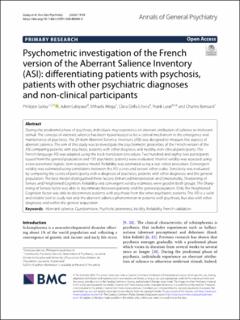| dc.contributor.author | Golay, Philippe | |
| dc.contributor.author | Laloyaux, Julien | |
| dc.contributor.author | Moga, Mihaela | |
| dc.contributor.author | Della Libera, Clara | |
| dc.contributor.author | Larøi, Frank | |
| dc.contributor.author | Bonsack, Charles | |
| dc.date.accessioned | 2021-02-11T21:44:21Z | |
| dc.date.available | 2021-02-11T21:44:21Z | |
| dc.date.created | 2020-10-24T19:17:02Z | |
| dc.date.issued | 2020-10 | |
| dc.Published | Annals of General Psychiatry. 2020, 19:58 1-10. | |
| dc.identifier.issn | 1744-859X | |
| dc.identifier.uri | https://hdl.handle.net/11250/2727536 | |
| dc.description.abstract | During the prodromal phase of psychosis, individuals may experience an aberrant attribution of salience to irrelevant stimuli. The concept of aberrant salience has been hypothesized to be a central mechanism in the emergence and maintenance of psychosis. The 29-item Aberrant Salience Inventory (ASI) was designed to measure five aspects of aberrant salience. The aim of this study was to investigate the psychometric properties of the French version of the ASI comparing patients with psychosis, patients with other diagnosis and healthy, non-clinical participants. The French-language ASI was adapted using the back-translation procedure. Two hundred and eighty-two participants issued from the general population and 150 psychiatric patients were evaluated. Internal validity was assessed using a two-parameter logistic item response model. Reliability was estimated using a test–retest procedure. Convergent validity was estimated using correlations between the ASI scores and several other scales. Sensitivity was evaluated by comparing the scores of participants with a diagnosis of psychosis, patients with other diagnoses and the general population. The best model distinguished three factors: Enhanced Interpretation and Emotionality, Sharpening of Senses and Heightened Cognition. Reliability and convergent validity estimates were good in both groups. The Sharpening of Senses factor was able to discriminate between patients and the general population. Only the Heightened Cognition factor was able to discriminate patients with psychosis from the other psychiatric patients. The ASI is a valid and reliable tool to study not only the aberrant salience phenomenon in patients with psychosis, but also with other diagnoses and within the general population. | en_US |
| dc.language.iso | eng | en_US |
| dc.publisher | BMC | en_US |
| dc.rights | Navngivelse 4.0 Internasjonal | * |
| dc.rights.uri | http://creativecommons.org/licenses/by/4.0/deed.no | * |
| dc.title | Psychometric investigation of the French version of the Aberrant Salience Inventory (ASI): Differentiating patients with psychosis, patients with other psychiatric diagnoses and non-clinical participants | en_US |
| dc.type | Journal article | en_US |
| dc.type | Peer reviewed | en_US |
| dc.description.version | publishedVersion | en_US |
| dc.rights.holder | Copyright the author(s) | en_US |
| dc.source.articlenumber | 58 (2020) | en_US |
| cristin.ispublished | true | |
| cristin.fulltext | original | |
| cristin.qualitycode | 1 | |
| dc.identifier.doi | 10.1186/s12991-020-00308-0 | |
| dc.identifier.cristin | 1841957 | |
| dc.source.journal | Annals of General Psychiatry | en_US |
| dc.source.40 | 19:58 | |
| dc.source.pagenumber | 1-10 | en_US |
| dc.source.volume | 19 | en_US |

